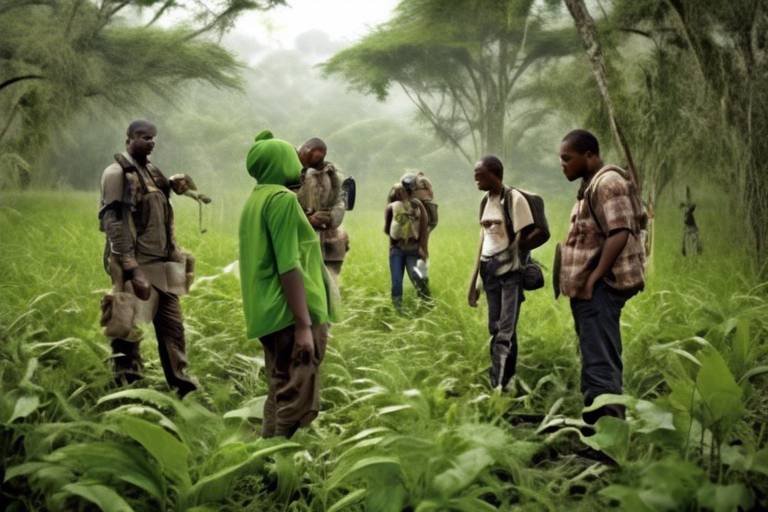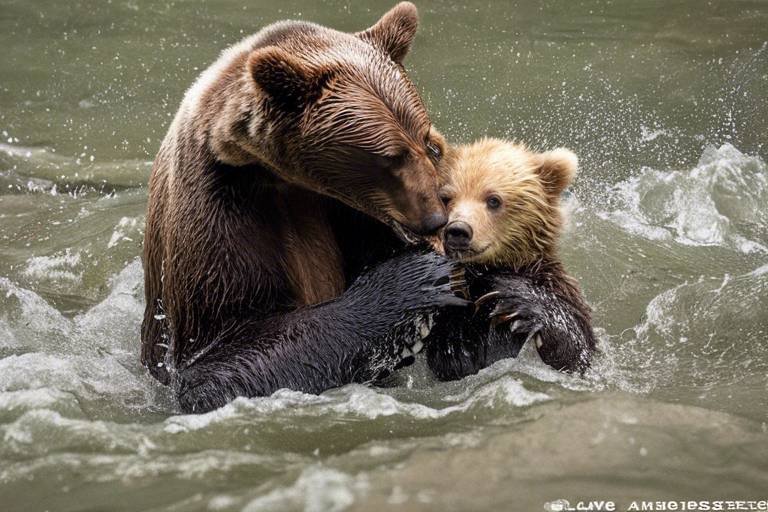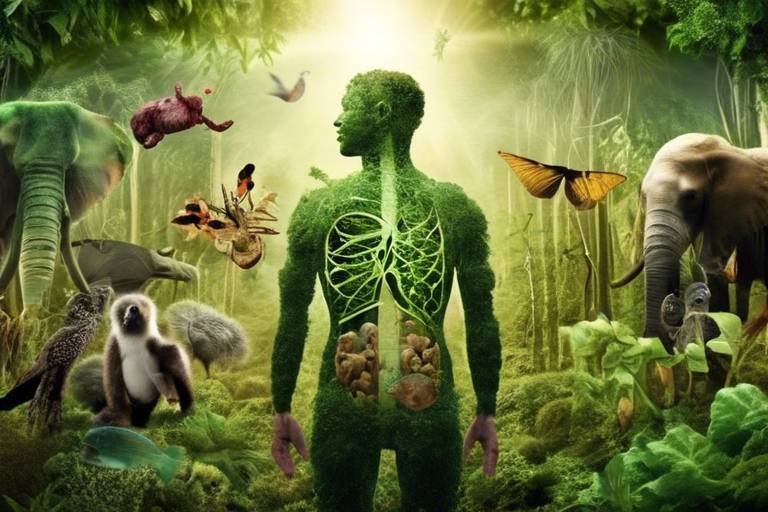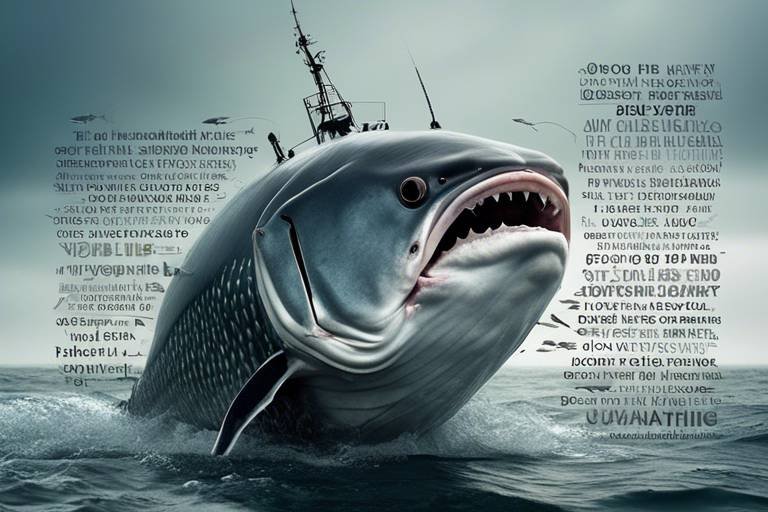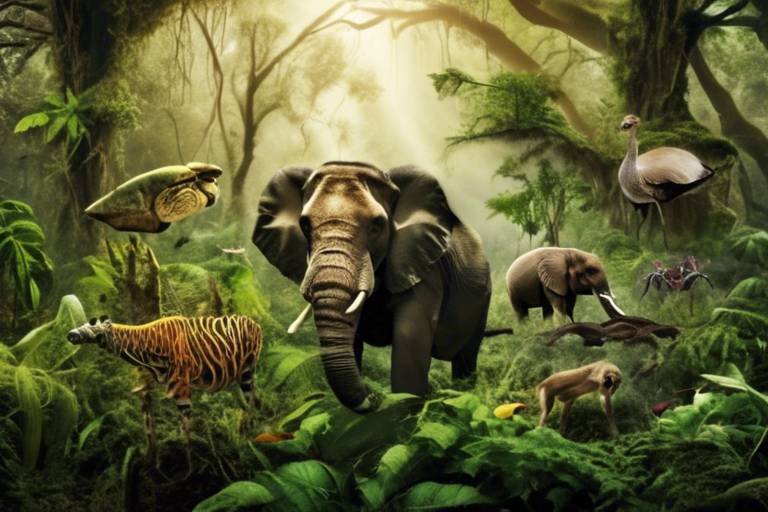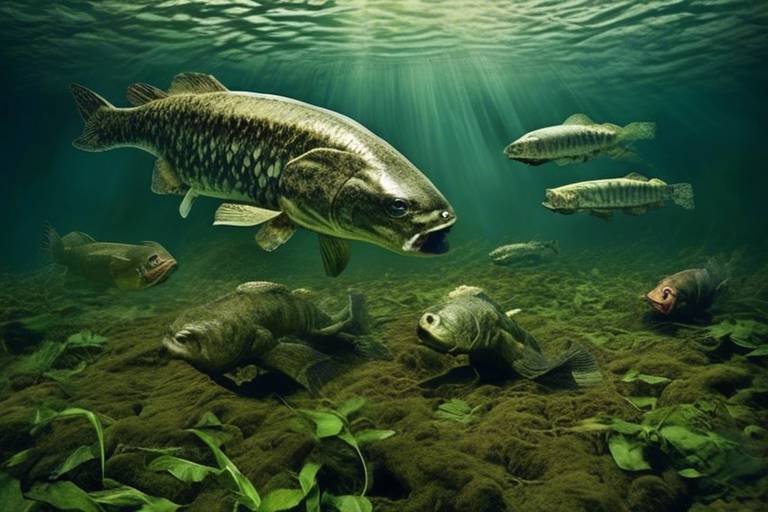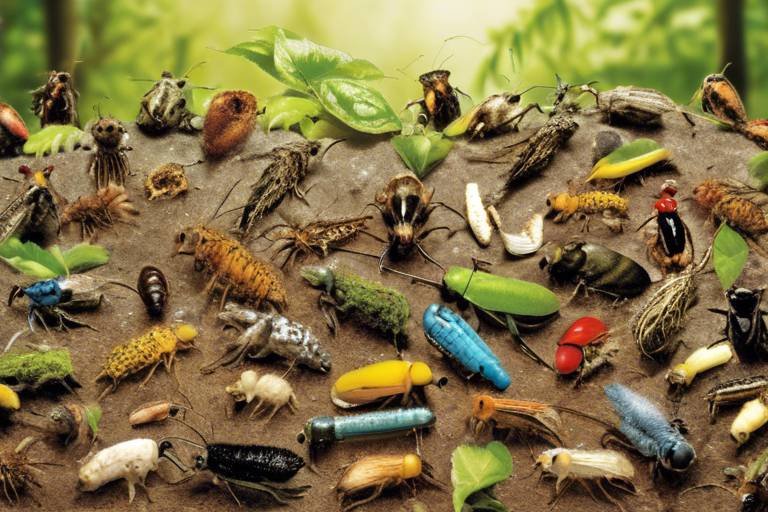The Threats to Ocean Biodiversity
Our oceans are a treasure trove of life, teeming with a staggering variety of species that contribute to the delicate balance of our planet's ecosystems. However, this incredible biodiversity is under siege from a multitude of threats that are rapidly escalating. It's a bit like watching a beautiful painting slowly fade away; each brushstroke represents a species, and as we lose them, the picture becomes less vibrant. The urgency to address these threats has never been more critical, as the health of our oceans directly impacts not just marine life, but humanity as well. So, what are the primary culprits behind the decline in ocean biodiversity? Let’s dive deep into the murky waters of pollution, climate change, overfishing, habitat destruction, and invasive species.
First off, we have pollution, which comes in many forms—plastics, chemicals, and agricultural runoff are just the tip of the iceberg. Each piece of trash that finds its way into the ocean can be a death sentence for marine creatures. Imagine a turtle mistaking a plastic bag for a jellyfish; it’s a tragic scenario that plays out far too often. The effects of pollution are not just limited to individual species; entire ecosystems can suffer degradation, leading to long-term health issues for marine populations. Understanding the sources of this pollution is crucial for mitigation efforts, as we can’t fix what we don’t understand.
Then there’s climate change, the silent killer of our oceans. As global temperatures rise, so do sea temperatures, which can lead to devastating consequences for marine ecosystems. Think of it as a fever that our oceans can’t shake off. The phenomenon of ocean acidification is equally alarming, making it harder for organisms like corals and shellfish to thrive. Coral reefs, often referred to as the rainforests of the sea, are particularly vulnerable. These beautiful structures are not just stunning to look at; they also provide essential habitat for countless species. Unfortunately, coral bleaching events, linked to climate change, are becoming increasingly common, threatening the very foundation of marine biodiversity.
To put things into perspective, let’s take a closer look at coral reefs. They are not only vital for marine biodiversity but also support local economies through tourism and fishing. The decline of these ecosystems poses a dual threat: it endangers countless marine species while also jeopardizing the livelihoods of communities that rely on them. Protecting coral reefs is not merely an environmental issue; it’s an economic one, too. Effective conservation strategies, such as establishing marine protected areas, can play a significant role in restoring these ecosystems and enhancing their resilience against climate change impacts.
Moreover, we can’t overlook the alarming rates of species extinction that are occurring due to habitat loss, overfishing, and climate-induced changes. Many marine species are hanging by a thread, and identifying those at risk is essential for targeted conservation efforts. The clock is ticking, and the stakes are high. If we don’t act now, we may lose unique species forever, which would be an irreplaceable loss for our oceans and for future generations.
Speaking of overfishing, this practice is wreaking havoc on fish populations and disrupting marine ecosystems. It’s akin to pulling out critical pieces from a jigsaw puzzle; eventually, the entire picture becomes distorted. The decline of key fish species can have cascading effects on marine food webs, altering predator-prey dynamics and threatening the survival of other marine organisms. The solution lies in promoting sustainable fishing practices, such as setting catch limits and supporting aquaculture. These measures can help restore fish populations and protect marine ecosystems for future generations.
Another significant threat comes from habitat destruction, driven by coastal development, bottom trawling, and other human activities. This destruction does not just impact individual species; it disrupts entire ecosystems. Marine habitats like mangroves and seagrasses are crucial for supporting biodiversity, protecting coastlines, and storing carbon. Their conservation is vital for ecosystem health, and active restoration efforts, including habitat rehabilitation and reforestation, can help recover damaged marine environments and promote biodiversity.
Lastly, we have the issue of invasive species, which can wreak havoc on local ecosystems by outcompeting native species for resources. Identifying and monitoring these invasive species is crucial for protecting native marine biodiversity and maintaining ecosystem balance. Implementing management strategies, such as public awareness campaigns and control measures, can mitigate the impacts of invasive species on marine ecosystems.
- What are the main threats to ocean biodiversity? The main threats include pollution, climate change, overfishing, habitat destruction, and invasive species.
- How does pollution affect marine life? Pollution can lead to habitat degradation, health issues for species, and even death due to ingestion of harmful materials.
- Why are coral reefs important? Coral reefs provide habitat for numerous marine species and support local economies through tourism and fishing.
- What can be done to combat overfishing? Promoting sustainable fishing practices, such as catch limits and aquaculture, can help restore fish populations.
- How can we protect marine habitats? Active restoration efforts and conservation strategies like marine protected areas are essential for preserving marine habitats.

Pollution and Its Impact
Pollution is one of the most pressing threats to ocean biodiversity, and its effects are felt far and wide across marine ecosystems. From the moment we wake up and use plastic products to the time we dispose of chemicals inappropriately, we contribute to a problem that has devastating consequences for our oceans. Plastic pollution alone is a staggering issue, with millions of tons of plastic entering the oceans each year. This plastic debris not only harms marine life through ingestion and entanglement but also breaks down into microplastics, which can infiltrate the food chain, affecting everything from tiny plankton to the largest whales.
In addition to plastics, chemical pollution from agricultural runoff, industrial waste, and sewage discharge introduces harmful substances into marine environments. These chemicals can lead to habitat degradation, disrupting the delicate balance of marine ecosystems. For instance, nutrient runoff can cause eutrophication, a process that leads to algal blooms. These blooms deplete oxygen in the water, creating dead zones where marine life cannot survive. The consequences are dire, affecting not only fish populations but also the communities that rely on these species for their livelihoods.
Understanding the sources and effects of pollution is crucial for effective mitigation efforts. Here’s a brief overview of the types of pollution impacting our oceans:
| Type of Pollution | Sources | Impacts on Marine Life |
|---|---|---|
| Plastic Pollution | Single-use plastics, fishing gear, packaging | Ingestion, entanglement, habitat destruction |
| Chemical Pollution | Agricultural runoff, industrial discharge, sewage | Eutrophication, toxic effects, habitat degradation |
| Noise Pollution | Shipping, industrial activities, naval exercises | Disruption of communication, navigation, and mating |
As we delve deeper into the issue, it's evident that pollution is not just an environmental issue; it’s a public health concern as well. The toxins that accumulate in fish and other seafood can have serious implications for human health, leading to a cycle of harm that affects both marine and terrestrial ecosystems. This interconnectedness highlights the urgency for comprehensive policies and community actions aimed at reducing pollution levels.
So, what can we do to combat this growing threat? It starts with awareness and education. By understanding how our daily choices impact the ocean, we can make more informed decisions. Simple actions like reducing plastic use, supporting sustainable products, and advocating for better waste management practices can collectively lead to significant change. It’s all about taking responsibility and working together to protect our oceans for future generations.
- What are the main sources of ocean pollution?
Ocean pollution primarily comes from plastics, chemicals, agricultural runoff, and sewage discharge. - How does pollution affect marine life?
Pollution leads to habitat degradation, health issues, and can cause species decline or extinction. - What can individuals do to reduce ocean pollution?
Individuals can reduce plastic use, support sustainable products, and advocate for better waste management practices.

Climate Change Effects
Climate change is not just a distant threat; it's a reality that is reshaping our oceans and the life within them. As the planet warms, we see rising sea temperatures and increasing ocean acidification, both of which pose significant threats to marine ecosystems. Imagine the ocean as a giant, intricate web of life, where every strand relies on the others to maintain balance. When one strand weakens due to stress from climate change, the entire web can begin to unravel.
Rising sea temperatures can lead to severe consequences for various marine species. For instance, many fish species, which are sensitive to temperature changes, may find their habitats unsuitable, forcing them to migrate to cooler waters. This shift can disrupt established ecosystems and alter predator-prey relationships. Furthermore, the impact of ocean acidification—caused by increased carbon dioxide absorption—can hinder the ability of shellfish and corals to form their shells and skeletons, essentially threatening their survival.
One of the most visible and alarming effects of climate change is coral bleaching. Coral reefs, often referred to as the "rainforests of the sea," are incredibly biodiverse ecosystems that support a vast array of marine life. However, when water temperatures rise, corals expel the algae living in their tissues, leading to a loss of color and vital nutrients. This phenomenon not only endangers the corals themselves but also the myriad of species that depend on them for food and shelter. The ramifications are profound, as coral reefs provide habitat for approximately 25% of all marine species, according to the World Wildlife Fund.
Coral reefs are suffering from more than just bleaching; they are also increasingly vulnerable to other stressors exacerbated by climate change, such as ocean acidification and pollution. Protecting these ecosystems is essential, not just for maintaining fish populations but also for coastal protection and tourism revenue. For communities that rely heavily on these reefs for their livelihoods, the stakes couldn't be higher.
To understand the importance of coral reefs, consider them as the foundation of marine biodiversity. They provide habitat for countless marine species and support local economies through tourism and fishing. Their decline threatens both biodiversity and human livelihoods, making their conservation a pressing issue. In fact, healthy coral reefs can significantly contribute to coastal resilience, acting as natural barriers against storms and erosion.
Implementing effective conservation strategies is crucial for restoring coral reefs and promoting resilience against climate change impacts. Initiatives such as establishing marine protected areas (MPAs) can help safeguard these vital ecosystems. MPAs restrict human activity in designated areas, allowing marine life to thrive and recover. Moreover, community engagement in conservation efforts can foster a sense of stewardship, ensuring that local populations are invested in the health of their marine environment.
In summary, the effects of climate change on ocean biodiversity are profound and multifaceted. From rising temperatures and ocean acidification to the degradation of critical habitats like coral reefs, every aspect of marine life is interconnected. The time for action is now; we must recognize the urgency of these issues and work collectively to mitigate their impacts. By doing so, we can help preserve the intricate web of life that exists beneath the waves.
- What are the main causes of climate change affecting the oceans?
Climate change is primarily driven by human activities, including the burning of fossil fuels, deforestation, and industrial processes that increase greenhouse gas emissions. - How does ocean acidification occur?
Ocean acidification happens when the ocean absorbs excess carbon dioxide from the atmosphere, leading to a decrease in pH levels, which affects marine organisms, particularly those with calcium carbonate structures. - Why are coral reefs important?
Coral reefs support a diverse range of marine species, protect coastlines from erosion, and provide economic benefits through tourism and fisheries. - What can individuals do to help combat climate change?
Individuals can reduce their carbon footprint by using public transportation, conserving energy, supporting sustainable seafood, and participating in local conservation efforts.

Coral Reef Degradation
Coral reefs are often referred to as the "rainforests of the sea," and for good reason. These vibrant ecosystems are teeming with life and play a crucial role in maintaining marine biodiversity. However, they are currently facing a severe crisis due to climate change and human activities. One of the most alarming phenomena associated with coral reefs is coral bleaching, which occurs when corals become stressed due to rising sea temperatures. When this happens, corals expel the colorful algae (zooxanthellae) that live in their tissues, leading to a stark white appearance and a loss of vital nutrients. Without these algae, corals struggle to survive, making them more susceptible to disease and mortality.
In addition to climate change, other factors contribute to the degradation of coral reefs, including:
- Pollution: Runoff from agricultural fertilizers, sewage, and plastics can lead to nutrient overloads in the water, resulting in harmful algal blooms that suffocate coral.
- Overfishing: The depletion of key fish species disrupts the balance of the reef ecosystem, as these fish play essential roles in maintaining coral health.
- Coastal Development: Construction and land reclamation can physically damage coral habitats, while increased sedimentation can smother corals and reduce their access to sunlight.
The loss of coral reefs is not just an environmental issue; it has profound implications for millions of people who rely on these ecosystems for their livelihoods. Coastal communities depend on healthy reefs for fishing, tourism, and protection from storm surges. The economic impact of coral reef degradation can be staggering, with estimates suggesting that the global value of coral reefs exceeds $375 billion annually. Thus, protecting these ecosystems is not merely an ecological necessity but also a vital economic imperative.
Efforts to combat coral reef degradation must focus on both prevention and restoration. Establishing marine protected areas (MPAs) can help shield vulnerable reefs from human impacts, while active restoration initiatives, such as coral gardening and transplantation, can aid in the recovery of damaged reefs. Moreover, raising public awareness about the importance of coral reefs and the threats they face is crucial. By fostering a sense of stewardship and encouraging sustainable practices, we can work towards a future where coral reefs thrive once again.
Q: What causes coral bleaching?
A: Coral bleaching is primarily caused by stress from rising sea temperatures, pollution, and other environmental changes that lead corals to expel their symbiotic algae.
Q: How can we protect coral reefs?
A: Protecting coral reefs involves reducing pollution, establishing marine protected areas, promoting sustainable fishing practices, and raising awareness about their importance.
Q: Why are coral reefs important?
A: Coral reefs provide habitat for numerous marine species, support local economies through tourism and fishing, and protect coastlines from erosion and storm damage.

Importance of Coral Reefs
Coral reefs are often referred to as the "rainforests of the sea", and for good reason. These vibrant ecosystems are teeming with life and play a crucial role in maintaining the health of our oceans. They provide habitat for approximately 25% of all marine species, making them essential for biodiversity. Imagine walking through a bustling city filled with diverse communities; that’s what coral reefs are like underwater, bustling with various species cohabitating and thriving.
But the importance of coral reefs extends beyond just being a home for marine life. They serve as natural barriers that protect coastlines from erosion and storm surges. This is especially vital in the face of increasingly severe weather patterns due to climate change. Without these reefs, coastal communities would face greater risks from flooding and property damage. Additionally, they contribute to the economy through tourism and fishing. Many people travel the world to experience the beauty of coral reefs, supporting local economies and providing livelihoods for countless individuals.
Furthermore, coral reefs are significant in terms of their ecological functions. They support complex food webs and nutrient cycling, which are essential for the overall health of marine ecosystems. The algae that live within coral tissues not only give corals their color but also provide them with energy through photosynthesis. This symbiotic relationship underscores the interconnectedness of marine life. If we lose our coral reefs, we risk losing entire ecosystems that many species depend on for survival.
In summary, the importance of coral reefs cannot be overstated. They are vital for biodiversity, coastal protection, economic sustainability, and ecological balance. Protecting these ecosystems is not just about saving the corals themselves; it’s about preserving a way of life for countless species, including humans. As we continue to face environmental challenges, it’s imperative that we prioritize the conservation of coral reefs to ensure a healthy future for our oceans.
- What are coral reefs made of? Coral reefs are primarily made up of calcium carbonate, which is secreted by tiny marine animals called corals.
- Why are coral reefs declining? Coral reefs are declining due to factors such as climate change, ocean acidification, pollution, and overfishing.
- How can we protect coral reefs? We can protect coral reefs by reducing pollution, supporting sustainable fishing practices, and establishing marine protected areas.
- What role do coral reefs play in the ecosystem? Coral reefs provide habitat for marine species, protect coastlines, and contribute to nutrient cycling within marine ecosystems.

Conservation Strategies
To effectively combat the myriad threats facing ocean biodiversity, it is vital to implement robust . These strategies not only aim to protect marine ecosystems but also promote resilience against the ongoing impacts of climate change and human activity. One of the most effective approaches is the establishment of marine protected areas (MPAs). These designated zones restrict human activity, allowing ecosystems to recover and thrive. Research has shown that MPAs can lead to increased biodiversity, improved fish stocks, and healthier marine environments.
Another important conservation strategy involves the restoration of damaged habitats. This can include efforts such as replanting seagrasses, rebuilding coral reefs, and rehabilitating mangroves. These ecosystems are not just crucial for marine life; they also serve as natural barriers against storms and coastal erosion, making their preservation a win-win for both nature and human communities. Active restoration efforts can be labor-intensive but are essential for reversing the damage done by pollution and habitat destruction.
Public education and community involvement are also key components of successful conservation strategies. When local communities understand the importance of their marine environments, they are more likely to engage in sustainable practices. Awareness campaigns can help people recognize the impact of their actions, leading to more responsible behaviors, such as reducing plastic use and supporting sustainable fishing practices.
Collaboration among governments, NGOs, and local communities is essential for the success of these conservation strategies. By pooling resources, sharing knowledge, and working towards common goals, stakeholders can create comprehensive conservation plans that address the specific needs of different marine ecosystems. For example, a collaborative approach might include:
- Establishing fishing quotas to prevent overfishing.
- Implementing strict regulations on coastal development.
- Encouraging eco-tourism to promote economic benefits while conserving habitats.
Finally, ongoing research and monitoring are crucial to adapt conservation strategies to changing conditions. By continuously assessing the health of marine ecosystems and the effectiveness of conservation measures, we can adjust our approaches to ensure they remain relevant and impactful. The ocean is a dynamic environment, and our strategies must be just as dynamic to safeguard its biodiversity for future generations.
Q: What are marine protected areas (MPAs)?
A: Marine protected areas are designated regions in oceans where human activities are restricted to conserve marine biodiversity and ecosystems.
Q: Why are coral reefs important?
A: Coral reefs provide essential habitats for numerous marine species, support local economies through tourism and fishing, and protect coastlines from erosion.
Q: How can individuals help with ocean conservation?
A: Individuals can contribute by reducing plastic use, supporting sustainable seafood, participating in beach clean-ups, and advocating for marine conservation policies.

Species Extinction Risks
As we navigate through the turbulent waters of environmental changes, the specter of species extinction looms larger than ever. Many marine species are facing extinction due to a combination of factors, including habitat loss, overfishing, and the relentless impacts of climate change. Just like a house of cards, once one species is removed, the entire ecosystem can begin to crumble, leading to a domino effect that threatens countless others.
One of the most alarming aspects of this crisis is the rapid rate at which we are losing biodiversity. According to the International Union for Conservation of Nature (IUCN), nearly one-third of marine species are currently at risk of extinction. This statistic is not just a number; it represents a significant loss of genetic diversity and ecosystem resilience. Imagine a vibrant tapestry—each thread representing a different species. Pulling out too many threads weakens the whole fabric, making it more susceptible to tearing and fraying.
Some of the most vulnerable species include iconic marine life such as sea turtles, sharks, and various fish species. These creatures are not just essential for their ecosystems; they also play critical roles in human economies and cultures. For instance, the decline of shark populations can lead to an overabundance of smaller fish, which in turn disrupts the marine food web. This imbalance can have far-reaching consequences, affecting everything from local fishing industries to global seafood markets.
To better understand the risks, let's consider the following table that highlights some of the key factors contributing to marine species extinction:
| Factor | Description | Impact on Species |
|---|---|---|
| Habitat Loss | Destruction of marine habitats due to coastal development and pollution. | Reduces breeding grounds and food sources. |
| Overfishing | Unsustainable fishing practices leading to population declines. | Threatens key species and disrupts food chains. |
| Climate Change | Rising temperatures and ocean acidification affecting species survival. | Alters habitats and reproductive patterns. |
| Invasive Species | Non-native species outcompeting local species for resources. | Displaces native species and disrupts ecosystems. |
Recognizing these risks is the first step toward action. Conservationists and scientists are working tirelessly to identify at-risk species and implement targeted conservation strategies. These efforts range from establishing marine protected areas to enforcing sustainable fishing regulations. However, the responsibility does not rest solely on the shoulders of scientists and policymakers; it is a collective challenge that requires public awareness and engagement.
So, what can you do? Start by educating yourself and others about the importance of marine biodiversity. Participate in local beach clean-ups, support sustainable seafood initiatives, and advocate for policies that protect our oceans. Every small action contributes to a larger wave of change, ensuring that future generations can enjoy the rich diversity of life that our oceans have to offer. Remember, the survival of marine species is not just about preserving nature; it's about safeguarding our own future as well.
- What are the main causes of marine species extinction?
Habitat loss, overfishing, climate change, and invasive species are the primary threats to marine biodiversity. - How can I help protect marine species?
Engaging in conservation efforts, supporting sustainable practices, and raising awareness are effective ways to contribute. - What role do marine protected areas play?
Marine protected areas help conserve biodiversity by providing safe havens for species to thrive and recover.

Overfishing and Its Consequences
Overfishing is more than just a buzzword; it’s a **serious threat** to our oceans and the delicate balance of marine ecosystems. When we talk about overfishing, we’re referring to the practice of catching fish at a rate faster than they can reproduce. This unsustainable practice doesn’t just deplete fish populations; it sends shockwaves through the entire marine food web. Imagine a house of cards—remove one card, and the whole structure starts to wobble. That’s what happens when key fish species disappear.
As fish populations dwindle, the **consequences** ripple through the ecosystem. For instance, predators that rely on these fish for food may struggle to survive, leading to a decline in their populations as well. This creates a domino effect that can alter predator-prey dynamics and disrupt the entire marine community. The decline of certain fish species can lead to an overabundance of others, creating imbalances that can be devastating for biodiversity.
One of the most concerning aspects of overfishing is its impact on **economic stability** for communities that depend on fishing for their livelihoods. Many coastal communities rely on fishing not just for food but as a primary source of income. When fish stocks are overexploited, it threatens the very foundation of these communities. According to recent studies, over 90% of the world's fisheries are either fully exploited or overfished, which is a staggering statistic that calls for immediate action.
To visualize the impact of overfishing, consider the following table that outlines the **current status of global fish stocks**:
| Fish Stock Status | Percentage of Global Stocks |
|---|---|
| Overfished | 34% |
| Fully Exploited | 53% |
| Underfished | 13% |
These figures are alarming and highlight the **urgency** of adopting sustainable fishing practices. Sustainable fishing isn’t just a trendy term; it’s a necessity. Implementing practices like catch limits, seasonal closures, and promoting aquaculture can help restore fish populations. It's like giving the ocean a chance to breathe and recover. When we fish sustainably, we ensure that future generations can enjoy the same resources we have today.
Furthermore, the **consequences of overfishing** extend beyond just the fish. The entire marine ecosystem suffers. For example, the decline of herbivorous fish can lead to the overgrowth of algae on coral reefs, which can result in coral bleaching and the eventual death of these vital ecosystems. Coral reefs are not just beautiful; they provide habitat for countless marine species and support local economies through tourism and fishing. Protecting them means protecting our oceans.
In conclusion, the fight against overfishing is a fight for the future of our oceans. It’s not just about saving fish; it's about preserving the intricate web of life that depends on them. By choosing sustainable practices and supporting policies aimed at conservation, we can help ensure that our oceans remain vibrant and healthy for generations to come. So, the next time you’re at the market or ordering seafood, think about the impact of your choices. Together, we can make a difference.
- What is overfishing? Overfishing occurs when fish are caught faster than they can reproduce, leading to declining fish populations.
- How does overfishing affect marine ecosystems? Overfishing disrupts the balance of marine food webs, affecting predator-prey relationships and overall biodiversity.
- What can be done to combat overfishing? Implementing sustainable fishing practices, such as catch limits and promoting aquaculture, can help restore fish populations.
- Why are coral reefs important? Coral reefs provide habitat for numerous marine species and support local economies through tourism and fishing.

Impact on Fish Populations
The decline of fish populations due to overfishing has profound implications for marine ecosystems. When key species are removed from the ocean, the entire food web can become unbalanced, leading to a domino effect that threatens the survival of various marine organisms. Imagine a bustling city where a significant number of its inhabitants suddenly vanish; the remaining residents would struggle to maintain order, and chaos would ensue. Similarly, when we overfish certain species, such as cod or tuna, we disrupt the natural predator-prey relationships that have evolved over millennia.
For instance, if a predator fish is overfished, its prey species may experience a population explosion, leading to overgrazing of essential habitats like seagrass beds or coral reefs. This imbalance can result in the degradation of these critical ecosystems, which serve as nurseries for many fish species and provide essential services for coastal communities. To illustrate this point, consider the following table that highlights the interconnectedness of fish populations and their ecosystems:
| Fish Species | Role in Ecosystem | Consequences of Decline |
|---|---|---|
| Cod | Top predator | Increase in prey species like herring, leading to overgrazing |
| Sea Urchins | Herbivore | Overpopulation can destroy kelp forests, affecting biodiversity |
| Tuna | Predator | Decrease in smaller fish populations, disrupting the food chain |
Moreover, the decline of fish populations can have significant economic repercussions. Coastal communities that rely on fishing for their livelihoods face uncertainty and instability as fish stocks dwindle. This situation not only threatens food security but also diminishes the cultural heritage associated with fishing traditions. It's a harsh reality that many communities are grappling with, as they watch their once-thriving industries falter.
To combat these challenges, sustainable fishing practices are essential. By implementing catch limits, promoting aquaculture, and supporting local fisheries management, we can help restore fish populations and ensure the long-term health of marine ecosystems. It’s crucial for policymakers, fishermen, and consumers to work together to make informed choices that prioritize sustainability. After all, a healthy ocean is not just a benefit for marine life; it’s a necessity for human well-being, too.
- What are the main causes of fish population decline? Overfishing, habitat destruction, pollution, and climate change are the primary drivers of fish population decline.
- How does overfishing affect the food web? Overfishing disrupts predator-prey relationships, leading to imbalances that can threaten the survival of other marine organisms.
- What can be done to restore fish populations? Implementing sustainable fishing practices, enforcing catch limits, and supporting marine protected areas are effective strategies for restoring fish populations.
- Why are fish populations important for coastal communities? Fish populations are vital for food security, economic stability, and the preservation of cultural heritage in coastal communities.

Sustainable Fishing Practices
Sustainable fishing practices are essential for ensuring the long-term health of our oceans and the myriad of life they support. As fish populations dwindle due to overfishing, the need for responsible management of marine resources has never been more critical. Sustainable fishing isn't just a trend; it's a lifeline for our oceans, communities, and future generations. But what does it really mean to fish sustainably?
At its core, sustainable fishing involves methods that maintain fish populations at healthy levels while minimizing environmental impact. This can include practices such as setting catch limits, which are scientifically determined quotas that prevent overfishing by ensuring that only a certain number of fish can be caught each season. These limits are crucial for allowing fish populations to regenerate and thrive.
Another vital aspect of sustainable fishing is the promotion of aquaculture, or fish farming. This practice can reduce the pressure on wild fish stocks by providing an alternative source of fish. However, it's important to ensure that aquaculture is conducted responsibly, avoiding practices that harm local ecosystems. For instance, fish farms should not be located in sensitive habitats like mangroves or coral reefs, which are essential for biodiversity.
Moreover, using selective fishing gear can significantly reduce bycatch, which is the capture of unintended species. By employing nets and traps designed to target specific fish, fishermen can help protect vulnerable species and maintain the balance of marine ecosystems. This not only helps sustain fish populations but also supports the livelihoods of those who depend on fishing by ensuring that they can continue to fish for generations to come.
Education and awareness are also key components of sustainable fishing. By informing consumers about the importance of choosing sustainably sourced seafood, we can drive demand for responsible fishing practices. Many organizations and seafood guides provide valuable information on which fish are caught sustainably, helping consumers make informed choices. This can create a ripple effect, encouraging more fishermen to adopt sustainable practices in order to meet consumer demand.
To further illustrate the impact of sustainable fishing, consider the following table that compares traditional fishing practices with sustainable alternatives:
| Aspect | Traditional Fishing Practices | Sustainable Fishing Practices |
|---|---|---|
| Fish Population Impact | Overfishing, leading to population decline | Maintained fish populations through quotas |
| Environmental Impact | High bycatch and habitat destruction | Low bycatch, minimal habitat disruption |
| Community Benefits | Short-term profits, long-term losses | Long-term viability and community resilience |
In conclusion, adopting sustainable fishing practices is not just a choice; it's a necessity for the health of our oceans and the survival of countless species. By understanding the implications of our fishing methods and making conscious decisions, we can all contribute to a more sustainable future. Whether you are a fisherman, a consumer, or an advocate, your actions matter. Together, we can ensure that our oceans remain vibrant and full of life for generations to come.
- What is sustainable fishing? Sustainable fishing refers to practices that maintain fish populations at healthy levels while minimizing environmental impact.
- Why is sustainable fishing important? It helps preserve marine ecosystems, supports local economies, and ensures that fish populations remain viable for future generations.
- How can I support sustainable fishing? You can support sustainable fishing by choosing seafood that is certified as sustainable and educating others about the importance of responsible fishing practices.

Habitat Destruction
Habitat destruction is one of the most pressing issues facing our oceans today. As human activities continue to expand, critical marine habitats are being lost at an alarming rate. This destruction is not just a statistic; it represents the loss of entire ecosystems that support an incredible variety of marine life. Whether it’s through coastal development, bottom trawling, or pollution, the impact on biodiversity is profound and often irreversible.
Coastal development, for instance, often leads to the destruction of vital ecosystems such as mangroves and salt marshes. These areas serve as nurseries for many fish species and provide essential services like coastal protection and carbon storage. When these habitats are destroyed, not only do we lose the species that rely on them, but we also jeopardize the natural barriers that protect our shorelines from storms and erosion.
Bottom trawling, another destructive practice, involves dragging heavy nets across the ocean floor. This method not only captures fish but also devastates the delicate habitats that exist on the seabed. The result is a barren landscape where once-thriving ecosystems flourished. The long-term effects of such practices can lead to a significant decline in fish populations and the overall health of marine environments.
To illustrate the scale of habitat destruction, consider the following table that highlights some of the most affected marine habitats and their significance:
| Marine Habitat | Significance | Threats |
|---|---|---|
| Mangroves | Nursery for fish, coastal protection | Coastal development, pollution |
| Coral Reefs | Biodiversity hotspot, tourism | Climate change, overfishing |
| Seagrasses | Carbon storage, habitat for marine life | Pollution, boat propeller damage |
It’s essential to recognize that the destruction of these habitats doesn't just affect marine life; it also impacts human communities. Many coastal communities rely on healthy marine ecosystems for their livelihoods, whether through fishing, tourism, or recreation. When habitats are degraded, the economic and social fabric of these communities is at risk.
Restoration efforts are crucial in reversing the damage done to marine habitats. This can involve rehabilitation projects, such as replanting mangroves or restoring coral reefs, which not only help revive these ecosystems but also provide significant benefits to local communities. By investing in restoration, we can promote biodiversity and resilience in our oceans.
As we move forward, it’s vital for policymakers, conservationists, and communities to work together to protect and restore marine habitats. The survival of countless marine species and the health of our oceans depend on our ability to address habitat destruction effectively.
- What are the main causes of habitat destruction in the oceans? Habitat destruction is primarily caused by coastal development, bottom trawling, pollution, and climate change.
- How does habitat destruction affect marine life? It leads to the loss of biodiversity, disrupts food webs, and can result in the extinction of vulnerable species.
- What can be done to prevent habitat destruction? Implementing sustainable practices, establishing marine protected areas, and engaging in restoration efforts are key strategies.
- Why are mangroves important to marine ecosystems? Mangroves provide critical habitats for fish, protect coastlines from erosion, and help sequester carbon.
- How can individuals contribute to ocean conservation? Individuals can support conservation organizations, reduce plastic use, and participate in local clean-up efforts.

Importance of Marine Habitats
Marine habitats are the lifeblood of our oceans, providing essential ecosystems that support a myriad of life forms. These habitats, which include mangroves, seagrasses, and coral reefs, play critical roles not only for marine biodiversity but also for human communities that rely on them. Just imagine a bustling city with no parks or green spaces; similarly, without healthy marine habitats, our oceans would struggle to thrive.
One of the key functions of marine habitats is their ability to support biodiversity. For instance, coral reefs are often referred to as the "rainforests of the sea" because they harbor an astonishing variety of species. These underwater ecosystems provide shelter, breeding grounds, and feeding areas for countless marine organisms. In fact, it is estimated that coral reefs support about 25% of all marine life. Without these habitats, many species would face extinction, leading to a domino effect that could disrupt entire marine ecosystems.
Moreover, marine habitats are crucial for coastal protection. Mangroves, for example, act as natural barriers against storm surges and coastal erosion. They absorb wave energy, reducing the impact of storms on coastal communities. This function is becoming increasingly important as climate change leads to more frequent and severe weather events. By preserving and restoring these habitats, we not only protect marine biodiversity but also safeguard human lives and property.
In addition to their ecological roles, marine habitats are vital for economic reasons. They support industries such as fishing and tourism, which are essential for the livelihoods of millions of people worldwide. For instance, healthy coral reefs attract tourists, generating revenue for local economies. Conversely, the degradation of these habitats can lead to significant economic losses. A study by the World Resources Institute found that the loss of coral reefs could cost the global economy up to $1 trillion over the next few decades. This highlights the interconnectedness of marine health and human prosperity.
To truly appreciate the importance of marine habitats, consider the following points:
- Carbon Sequestration: Marine habitats like seagrasses and mangroves are incredibly efficient at storing carbon, helping to combat climate change.
- Water Quality Improvement: These habitats filter pollutants and improve water quality, making oceans healthier for all marine life.
- Research and Education: Marine habitats serve as living laboratories for scientists and educators, providing invaluable insights into ecological processes and conservation strategies.
In summary, the importance of marine habitats cannot be overstated. They are essential for maintaining biodiversity, protecting coastlines, supporting economies, and mitigating climate change. As we face increasing threats to these vital ecosystems, it is imperative that we prioritize their conservation and restoration. By doing so, we ensure a healthier ocean and a more sustainable future for all.
- What are marine habitats? Marine habitats are environments in the ocean that support various forms of life, including coral reefs, mangroves, and seagrasses.
- Why are marine habitats important? They support biodiversity, protect coastlines, improve water quality, and contribute to the economy through tourism and fishing.
- How can we protect marine habitats? Conservation efforts such as establishing marine protected areas, reducing pollution, and promoting sustainable fishing practices can help protect these vital ecosystems.

Restoration Efforts
Restoration efforts in marine environments are crucial for reversing the damage caused by human activities and natural disasters. These initiatives aim to rehabilitate ecosystems that have suffered from pollution, overfishing, and habitat destruction. One of the most effective approaches to restoration is the active rehabilitation of critical habitats, such as coral reefs, mangroves, and seagrasses. By focusing on these vital ecosystems, we can not only enhance biodiversity but also improve the overall health of our oceans.
For instance, coral reef restoration involves techniques like coral gardening, where fragments of healthy corals are cultivated in nurseries and later transplanted onto damaged reefs. This method has shown promising results in various locations around the world, helping to revive coral populations and restore the complex structures that provide habitat for numerous marine species.
Mangrove restoration is another vital effort, as these coastal ecosystems serve as nurseries for many fish species and protect shorelines from erosion. Projects aimed at replanting mangroves have demonstrated significant success, leading to increased fish populations and improved coastal resilience. Similarly, seagrass restoration initiatives are essential for maintaining water quality and providing habitat for marine life. These efforts often involve replanting seagrass in areas where it has declined, thus promoting biodiversity and enhancing ecosystem services.
However, restoration is not just about planting new life; it also requires ongoing monitoring and management. This ensures that the restored areas thrive and continue to provide benefits to both marine life and human communities. For example, regular assessments can help identify any emerging threats, such as invasive species or pollution, allowing for timely interventions. The table below summarizes some key restoration techniques and their benefits:
| Restoration Technique | Benefits |
|---|---|
| Coral Gardening | Revives coral populations, enhances biodiversity. |
| Mangrove Replanting | Protects shorelines, serves as fish nurseries. |
| Seagrass Restoration | Improves water quality, provides habitat for marine life. |
In addition to these techniques, community involvement is vital for the success of restoration projects. Engaging local communities not only fosters a sense of ownership but also ensures that traditional knowledge and practices are incorporated into restoration efforts. Educational programs and volunteer opportunities can empower individuals to take part in conservation activities, creating a stronger bond between people and their marine environments.
Ultimately, restoration efforts are a beacon of hope for our oceans. By combining science, community engagement, and sustainable practices, we can pave the way for healthier marine ecosystems. It’s a collective responsibility that requires commitment from governments, organizations, and individuals alike. Together, we can make a significant impact and help secure a vibrant future for our ocean biodiversity.
- What is marine restoration? Marine restoration involves activities aimed at recovering and rehabilitating degraded marine ecosystems to restore their natural functions and biodiversity.
- Why are coral reefs important? Coral reefs provide habitat for countless marine species, support local economies through tourism and fishing, and protect coastlines from erosion.
- How can individuals help in marine restoration efforts? Individuals can participate in local conservation projects, advocate for sustainable practices, and educate others about the importance of marine ecosystems.
- What are some challenges faced in marine restoration? Challenges include funding limitations, climate change impacts, and the presence of invasive species that can hinder restoration efforts.

Invasive Species Threats
Invasive species are like uninvited guests at a party—they crash into ecosystems, disrupt the natural order, and often outcompete native species for resources. These invasive organisms can be plants, animals, or microorganisms that have been introduced to an area where they do not naturally belong. The effects of these intruders can be devastating, leading to a decline in native biodiversity, altered habitats, and even economic consequences for local communities that depend on healthy marine environments.
One of the most alarming aspects of invasive species is their ability to reproduce rapidly and spread across vast areas. For instance, the lionfish, originally from the Indo-Pacific region, has established a stronghold in the Atlantic Ocean, preying on native fish and disrupting local ecosystems. Similarly, the green crab has invaded coastal waters, leading to significant declines in shellfish populations. These examples illustrate how invasive species can create a domino effect, where the decline of one species leads to the decline of others, ultimately threatening the entire marine food web.
Understanding the impacts of invasive species is crucial for developing effective management strategies. This involves not only identifying and monitoring these species but also educating the public about their threats. For instance, recreational boaters and fishermen can unknowingly transport invasive species from one body of water to another. Thus, public awareness campaigns play a vital role in preventing the spread of these harmful organisms.
To effectively combat the threat of invasive species, we need a multi-faceted approach that includes:
- Monitoring and Early Detection: Establishing programs to regularly check for invasive species in marine environments can help catch them before they spread.
- Public Education: Informing communities about how to recognize invasive species and the importance of reporting sightings can lead to quicker response times.
- Control Measures: Implementing strategies such as physical removal, chemical treatments, or biological controls can help manage existing populations of invasive species.
By taking these steps, we can protect our native marine biodiversity and ensure that ecosystems remain balanced. The fight against invasive species is not just about saving individual species; it’s about preserving the intricate web of life that supports us all. As we continue to face the challenges brought about by climate change and human activity, we must remain vigilant in our efforts to safeguard our oceans from these invasive threats.
- What are invasive species? Invasive species are non-native organisms that spread rapidly in a new environment, often causing harm to native species and ecosystems.
- How do invasive species affect marine ecosystems? They disrupt food chains, outcompete native species for resources, and can lead to significant declines in biodiversity.
- What can I do to help prevent the spread of invasive species? You can help by cleaning your boat and equipment before moving between water bodies, reporting sightings of invasive species, and educating others about their impacts.
- Are all non-native species invasive? No, not all non-native species are invasive. Some can coexist peacefully with native species without causing harm.

Identifying Invasive Species
Invasive species are like uninvited guests at a party—they show up unexpectedly and can cause chaos. Identifying these species is crucial because they can significantly disrupt local ecosystems, outcompeting native species for food and habitat. But how do we spot these troublemakers? It often requires a keen eye and a bit of research. Invasive species can come in various forms, including fish, plants, and invertebrates, and their impact can be devastating to biodiversity.
One of the first steps in identifying invasive species is understanding their characteristics. Many invasive species thrive in environments where they have no natural predators, allowing their populations to explode. For example, the lionfish, native to the Indo-Pacific, has become a notorious invasive species in the Caribbean, wreaking havoc on local fish populations. Its ability to reproduce rapidly and consume a wide variety of prey makes it a formidable threat.
To effectively identify invasive species, researchers and conservationists often employ a combination of field surveys and public reporting. Citizen science initiatives can play a vital role in this process. By encouraging local communities to report sightings of unusual species, we can gather valuable data on the distribution and impact of invasives. For instance, apps and online platforms can facilitate the sharing of information about invasive species sightings, helping to create a comprehensive database.
Another important aspect of identification is understanding the ecological context. Invasive species can sometimes resemble native species, making it challenging to distinguish between them. Therefore, it’s essential to provide educational resources that help individuals recognize the differences. For example, the northern snakehead fish, which is invasive in North America, can be confused with native species due to its similar appearance. However, the snakehead has distinct features, such as a long dorsal fin and a unique mouth structure, that can help in its identification.
In addition to visual identification, genetic testing can also be employed to confirm the presence of invasive species. This method is particularly useful for detecting species that may be difficult to identify based solely on physical characteristics. By analyzing DNA samples, scientists can determine whether a species is native or invasive, providing a more accurate assessment of ecosystem health.
Ultimately, the identification of invasive species is a crucial step in protecting marine biodiversity. By understanding who the invaders are, we can develop targeted management strategies to control their populations and mitigate their impact. This proactive approach not only helps preserve native species but also supports the overall health of marine ecosystems.
- What are invasive species? Invasive species are organisms that are introduced to a new environment where they do not naturally occur and can cause harm to local ecosystems.
- How do invasive species affect marine life? They can outcompete native species for resources, disrupt food webs, and lead to declines in biodiversity.
- What can I do to help identify invasive species? You can participate in citizen science projects, report sightings, and educate yourself and others about local invasive species.
- Are all non-native species invasive? No, not all non-native species are invasive. Some can coexist with native species without causing harm.

Management Strategies
Managing the threats posed by invasive species in marine ecosystems requires a multifaceted approach that combines science, community engagement, and policy. One of the most effective strategies is public awareness campaigns. By educating the public about the dangers of invasive species, we can foster a sense of responsibility and encourage proactive measures. For instance, informing boaters about cleaning their vessels before moving between different water bodies can significantly reduce the spread of invasive organisms.
Another crucial element in managing invasive species is the establishment of monitoring programs. These programs involve regular assessments of marine environments to identify the presence and impact of invasive species. By employing citizen scientists—enthusiastic volunteers who assist in data collection—we can enhance monitoring efforts while also raising awareness about marine biodiversity. This community involvement not only helps in tracking invasive species but also builds a network of informed advocates for marine conservation.
Additionally, implementing control measures is vital. This can include physical removal of invasive species, chemical treatments, or biological control methods, where natural predators are introduced to manage invasive populations. Each method comes with its own set of challenges and ethical considerations, which must be carefully evaluated to avoid unintended consequences on native species and ecosystems.
Collaboration between various stakeholders—government agencies, non-profit organizations, and local communities—is essential for developing and executing effective management strategies. For instance, a successful initiative might involve local fishermen working alongside scientists to monitor fish populations and report sightings of invasive species. This collaborative approach not only enhances the effectiveness of management strategies but also strengthens community ties and promotes a shared commitment to protecting marine biodiversity.
Finally, legislation plays a pivotal role in management strategies. Enforcing laws that regulate the introduction of non-native species and penalizing those who violate these regulations can deter the spread of invasives. Policies that promote sustainable practices, such as restrictions on ballast water discharge from ships, are crucial in preventing new invasions from occurring in the first place.
- What are invasive species? Invasive species are non-native organisms that, when introduced to a new environment, can disrupt local ecosystems, outcompete native species, and cause significant ecological and economic harm.
- How do invasive species affect marine biodiversity? They can alter food webs, reduce native species populations, and change habitat structures, leading to a decline in biodiversity and the overall health of marine ecosystems.
- What can individuals do to help manage invasive species? Individuals can help by cleaning boats and gear before moving between water bodies, reporting sightings of invasive species, and participating in local conservation efforts.
- Are there any successful examples of invasive species management? Yes, there are numerous success stories, such as the removal of invasive lionfish in the Caribbean, which has helped restore balance to local fish populations.
Frequently Asked Questions
- What are the main threats to ocean biodiversity?
The main threats to ocean biodiversity include pollution, climate change, overfishing, habitat destruction, and invasive species. Each of these factors contributes to the decline of marine ecosystems and the species that inhabit them.
- How does pollution affect marine life?
Pollution, particularly from plastics and chemicals, leads to habitat degradation and health issues for marine species. It can cause physical harm to animals, disrupt food chains, and result in the loss of biodiversity.
- What impact does climate change have on oceans?
Climate change causes rising sea temperatures and ocean acidification, which threaten marine ecosystems. These changes can affect species distribution, reproductive patterns, and overall ocean health, making immediate action crucial.
- Why are coral reefs important?
Coral reefs are vital for marine biodiversity as they provide habitat for countless species and support local economies through tourism and fishing. Their decline poses a significant threat to both marine life and human livelihoods.
- What is overfishing and why is it a problem?
Overfishing refers to catching fish at a rate faster than they can reproduce, which depletes fish populations and disrupts marine ecosystems. This imbalance can lead to a decline in biodiversity and the collapse of certain fish species.
- What are sustainable fishing practices?
Sustainable fishing practices include measures such as implementing catch limits, promoting aquaculture, and using methods that minimize environmental impact. These practices aim to preserve fish populations and protect marine ecosystems for future generations.
- How does habitat destruction affect marine biodiversity?
Habitat destruction, caused by activities like coastal development and bottom trawling, significantly impacts marine biodiversity. It leads to the loss of critical habitats that many species rely on for survival, thereby threatening their existence.
- What are invasive species and why are they a threat?
Invasive species are non-native organisms that disrupt local ecosystems by outcompeting native species for resources. They can alter food webs and lead to declines in native populations, threatening overall biodiversity.
- How can we manage invasive species?
Effective management strategies for invasive species include public awareness campaigns, monitoring programs, and control measures. These efforts help protect native marine biodiversity and maintain ecosystem balance.


